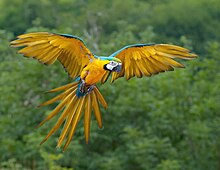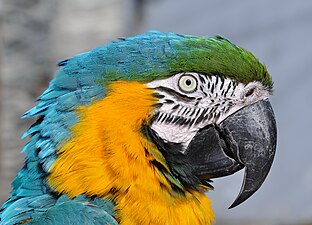Blue-and-yellow macaw
| Blue-and-yellow macaw | |
|---|---|

| |
| Male | |

| |
| Female Both at Jurong Bird Park | |
| Scientific classification | |
| Domain: | Eukaryota |
| Kingdom: | Animalia |
| Phylum: | Chordata |
| Class: | Aves |
| Order: | Psittaciformes |
| Family: | Psittacidae |
| Genus: | Ara |
| Species: | A. ararauna
|
| Binomial name | |
| Ara ararauna | |

| |
Distribution
| |
| Synonyms | |
|
Psittacus ararauna Linnaeus, 1758 | |
The blue-and-yellow macaw (Ara ararauna), also known as the blue-and-gold macaw, is a large Neotropical parrot with a mostly blue dorsum, light yellow/orange venter, and gradient hues of green on top of its head. It is a member of the large group of neotropical parrots known as macaws. It inhabits forest (especially varzea, but also in open sections of terra firme or unflooded forest), woodland and savannah of tropical Central and South America, as well as the island of Trinidad in the Caribbean. They are popular in aviculture because of their striking color, ability to talk, ready availability in the marketplace, and close bonding to humans. It is the most commonly kept macaw species in captivity worldwide as a pet or companion parrot and is also the cheapest among the large macaws. As of 2025, there are 1 million blue and gold macaws living in captivity worldwide, one of the highest population of any large parrot in captivity, such is the popularity of this bird.
Taxonomy
[edit]The blue-and-yellow macaw was formally described by the Swedish naturalist Carl Linnaeus in 1758 in the tenth edition of his Systema Naturae. He placed it with all the other parrots in the genus Psittacus and coined the binomial name Psittacus ararauna.[2] This macaw is now one of the eight extant species within the Ara genus, first proposed in 1799 by the French naturalist Bernard Germain de Lacépède.[3][4] The genus name is from ará meaning "macaw" in the Tupi language of Brazil. The word is an onomatopoeia based on the sound of their call. The specific epithet ararauna comes from the Tupi Arára úna meaning "big dark parrot" for the hyacinth macaw.[5] The word ararauna had been used by the German naturalist Georg Marcgrave in 1648 in his Historia Naturalis Brasiliae.[6] The species is monotypic: no subspecies are recognised.[4]
Description
[edit]These birds can reach a length of 81–91 cm (32–36 in) and weigh 1.0–1.5 kg (2–3 lb), making them some of the larger members of their family. They are vivid in appearance with bright aqua blue feathers on the top of their body except for the head, which is lime colored. The bottom, however, is a rich deep yellow/light orange. Their beak is black, as well as the feathers under their chin. Its feet are of a gray color, save for black talons. The bird has white skin, with its face having nearly no feathers beside a few black ones spaced apart from each other forming a striped pattern around the eyes. The irises are pale light yellow.[citation needed]
Blue-and-yellow macaws can live from 30 to 35 years in the wild, and reach sexual maturity between the ages of 3 and 6 years.[7]
Little variation in plumage is seen across the range. Some birds have a more orange or "butterscotch" underside color, particularly on the breast. This was often seen in Trinidad birds and others of the Caribbean area. The blue-and-yellow macaw uses its powerful beak for breaking nutshells, and for climbing up and hanging from trees.[7] As well as nuts, it will also feed on seeds, fruits, vegetable matter, bark and leaves, also insects, snails and small animals.[8][9]
Distribution and habitat
[edit]This species occurs in Panama, Trinidad and Tobago, Colombia, Suriname, French Guiana, Venezuela, Guyana, Peru, Brazil, Bolivia, Ecuador, and Paraguay. The range extends slightly into Central America, where it is restricted to Panama. While most breed in rural and forested areas, small numbers breed in urban cities such as Rondonópolis, Mato Grosso, Brazil, nesting in dead palms planted for ornamental purposes alongside city roads.[10] Although they were nearly wiped out in Trinidad due to human activity during the 1970s, a recent programme of reintroduction has proved successful. Between 1999 and 2003, wild-caught blue-and-yellow macaws were translocated from Guyana to Trinidad, in an attempt to reestablish the species in a protected area around the Nariva Swamp;[11] despite this, the IUCN still lists them as extirpated from the country. A small breeding population descended from introduced birds is found in Puerto Rico,[1] and another has inhabited Miami-Dade County, Florida, since the mid-1980s.[12]
Breeding
[edit]

The blue-and-yellow macaw generally mates for life. They nest almost exclusively in dead palms and most nests are in Mauritia flexuosa palms. The female typically lays two or three eggs. The female incubates the eggs for about 28 days. One chick is dominant and gets most of the food; the others perish in the nest. Chicks fledge from the nest about 97 days after hatching. The male bird's color signals readiness for breeding. The brighter and bolder the colors, the better the chance of getting a mate.[13]
Conservation and threats
[edit]The blue-and-yellow macaw is on the verge of being extirpated in Paraguay, but it still remains widespread and fairly common in a large part of mainland South America. The species is therefore listed as Least Concern by BirdLife International. Its wild population has not been quantified but is believed to be above 10,000 individuals and is in decline. It is listed on CITES Appendix II, trade restricted.[1]
Aviculture
[edit]Even well-tended blue-and-yellow macaws are known to "scream" for attention, and make other loud noises. Loud vocalizations, especially "flock calls", and destructive chewing are natural parts of their behavior and should be expected in captivity. Due to their large size, they also require plentiful space in which to fly around. According to World Parrot Trust, an enclosure for a blue-and-yellow macaw should, if possible, be at least 15 m (50 ft) in length.[14] Captive macaws, kept with good diet, exercise, and veterinary care are known to have lived 60 or more years.[15] People considering a macaw as a companion parrot must be aware of this and consider that the bird may outlive the owner.
The blue-and-yellow macaw has been noted to blush its bare facial skin and fluff the feathers of its cheeks, head and nape when interacting with humans. This may be an expression of the parrot's emotional state.[16]
Gallery
[edit]-
Head in high detail, Vogelburg (bird park), Weilrod, Germany
-
Two macaws, showing their colorful feathers
-
Flying at Zoo de Pont-Scorff, Morbihan, France
-
Blue and yellow macaw skeleton (Museum of Osteology)
-
At Walsrode Bird Park, Germany
-
Alligator Farm in Florida, US
-
Video clip
-
Macaw in captivity, Florida, US
-
Blue-and-yellow macaws in Brazil

See also
[edit]References
[edit]- ^ a b c BirdLife International (2018). "Ara ararauna". IUCN Red List of Threatened Species. 2018: e.T22685539A131917270. doi:10.2305/IUCN.UK.2018-2.RLTS.T22685539A131917270.en. Retrieved 12 November 2021.
- ^ Linnaeus, Carl (1758). Systema Naturae per regna tria naturae, secundum classes, ordines, genera, species, cum characteribus, differentiis, synonymis, locis (in Latin). Vol. 1 (10th ed.). Holmiae (Stockholm): Laurentii Salvii. p. 96.
- ^ Lacépède, Bernard Germain de (1799). "Tableau des sous-classes, divisions, sous-division, ordres et genres des oiseux". Discours d'ouverture et de clôture du cours d'histoire naturelle (in French). Paris: Plassan. p. 1. Page numbering starts at one for each of the three sections.
- ^ a b Gill, Frank; Donsker, David; Rasmussen, Pamela, eds. (January 2022). "Parrots, cockatoos". IOC World Bird List Version 12.1. International Ornithologists' Union. Retrieved 16 March 2022.
- ^ Jobling, James A. (2010). The Helm Dictionary of Scientific Bird Names. London: Christopher Helm. pp. 52, 53. ISBN 978-1-4081-2501-4.
- ^ Marcgrave, Georg (1648). Historia Naturalis Brasiliae (in Latin). Vol. Liber Quintus: Qui agit de Avibus. Lugdunum Batavorum (Leiden): Franciscum Hackium and Elzevirium. p. 206.
- ^ a b ffrench, Richard; O'Neill, John Patton; Eckelberry, Don R. (1991). A guide to the birds of Trinidad and Tobago (2nd ed.). Ithaca, N.Y.: Comstock Publishing. ISBN 978-0-8014-9792-6.
- ^ Hailey, A. "Ara ararauna (Blue-and-yellow Macaw)" (PDF). UWI St. Augustine. Retrieved 16 December 2023.
- ^ "Ara ararauna (Blue-and-yellow macaw)". Animal Diversity Web.
- ^ Angeoletto, Fabio; Tryjanowski, Piotr; Santos, Jeater; Martinez-Miranzo, Beatriz; Leandro, Deleon; Bohrer, João; Johann, Juciane Maria; Fellowes, Mark D. E. (June 2022). "Will Brazilian City Dwellers Actively Engage in Urban Conservation? A Case Study with the Charismatic Neotropical Blue-and-Yellow Macaw (Ara ararauna)". Birds. 3 (2): 234–244. doi:10.3390/birds3020015. ISSN 2673-6004.
- ^ Plair, B.L., Lal, M., Ramadhar, A., and Ramsubage, S. 2013. Status of Blue-and-yellow Macaws Ara ararauna Reintroduced to the Nariva Swamp, Trinidad and Tobago. Living World, Journal of The Trinidad and Tobago Field Naturalists' Club, 2013, 19–28.
- ^ Krishnan, Karunya. "Macaws on campus 'awesome' but noisy." The Miami Hurricane. 2009.
- ^ Alderton, David (2003). The Ultimate Encyclopedia of Caged and Aviary Birds. London, England: Hermes House. p. 235. ISBN 978-1-84309-164-6.
- ^ "Blue-and-yellow Macaw (Ara ararauna): Care". World Parrot Trust. Retrieved 26 September 2020.
- ^ "Blue & Gold Macaws aka Blue & Yellow Macaws". Beautyofbirds.com. Retrieved 24 April 2018.
- ^ Grrlscientist. "Macaws Communicate Their Emotions By Blushing And Fluffing Facial Feathers". Forbes. Retrieved 13 October 2021.
Further reading
[edit]- Doane, Bonnie Munro & Qualkinbush, Thomas (1994): My parrot, my friend : an owner's guide to parrot behavior. Howell Book House, New York. ISBN 0-87605-970-1
- Hilty, Steven L. (2003): Birds of Venezuela. Christopher Helm, London. ISBN 0-7136-6418-5
- Forshaw, J.M. Parrots of the World. New Jersey. T.F.H. Publications Inc. 1978. ISBN 0-87666-959-3
External links
[edit] Data related to Ara ararauna at Wikispecies
Data related to Ara ararauna at Wikispecies- World Parrot Trust Parrot Encyclopedia – Species Profile
- Blue-and-yellow macaw videos, photos & sounds on the Internet Bird Collection.
- IUCN Red List least concern species
- Ara (genus)
- Macaws
- Birds of Colombia
- Birds of Venezuela
- Birds of Brazil
- Birds of the Guiana Shield
- Birds of the Amazon rainforest
- Birds of the Cerrado
- Birds of Trinidad and Tobago
- Birds of the Caribbean
- Birds of Panama
- Talking birds
- Feral parrots
- Species that are or were threatened by the pet trade
- Birds described in 1758
- Taxa named by Carl Linnaeus
- Symbols of Tocantins









